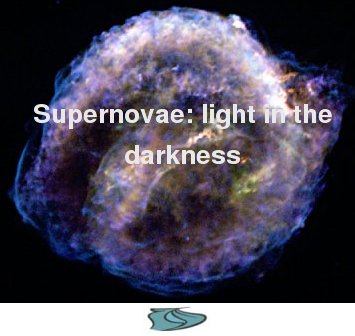
SUPERNOVA
October 3-5, 2007
Maó (Menorca)
published October 31, 2008
Maó (Menorca)
published October 31, 2008
Every year, at the end of the summer, the Section of Physics and Technique of the "Institut Menorquí d'Estudis" and the “Societat Catalana de Física" organize the "Trobades Científiques de la Mediterrània" with the support of several academic institutions.
The 2007 edition has been devoted to stellar explosions, the true evolutionary engines of galaxies. Whenever a star explodes, it injects into the interstellar medium a kinetic energy of 1051 erg and between one and several solar masses of newly synthesized elements as a result of the thermonuclear reactions that have taken place within the stellar interior. Two mechanisms are able to provide these enormous amounts of energy: one of them thermonuclear and the other, gravitational.
Thermonuclear supernovae are the result of the incineration of a carbon-oxygen white dwarf that is the compact star of a binary stellar system. If the two stars are sufficiently close to each other, the white dwarf accretes matter from its companion, approaches the mass of Chandrasekhar, and ends up exploding. The processes previous to the explosion, the explosion itself, as well as the exact nature of the double stellar system that explodes, are still a matter of discussion. This point is particularly important because these explosions, known as Type Ia Supernovae, are very homogenous and can be used to measure cosmological distances. The most spectacular result obtained, is the discovery of the accelerated expansion of the Universe, but it still feels uncomfortable that such a fundamental result is based on a "measuring system" whose origin and behaviour in time is unknown.
At the end of their lives, massive stars generate an iron nucleus that gets unstable when approaching the Chandrasekhar mass. Its collapse gives rise to the formation of a neutron star or a black hole, and the external manifestation of the energy that is released, about a 1053 erg, consists of a Type II or Ib/c supernova, of a Gamma Ray Burst (GRB) or even of both things. From the beginning of the nineties, when CGRO discovered the cosmological character of these phenomena, the GRB have constituted one of the most exciting problems of modern Astrophysics.
The stellar end products that leave supernovae, are as interesting as supernovae themselves. On one hand, as we previously said, they completely determine the chemical evolution of the Galaxy, which is fundamental for the formation of planets or, even, for the appearance of life. On the other hand, they leave collapsed objects such as neutron stars and black holes that give rise to a wide range of violent phenomena: x-rays eruptions, microquasars, acceleration of particles to high energies, etc.
The goal of this workshop was to bring together scientists with a deep insight into these topics and advanced PhD students, with the purpose of discussing in depth the remaining problems.
The organizers are specially grateful to DIUE-Generalitat de Catalunya, Ministerio de Educación y Ciencia, Balearic Island University, Barcelona University, Polythecnical University of Catalonia, Valencia University, CSIC and IFAE for their economical support.

| proceedings index |
|---|
|
Joule heating governing the cooling of magnetized neutron stars
|
|
Ultrarelativistic outflows associated to progenitors of Gamma-Ray bursts
|
|
The role of Supernovae in Galaxy evolution
|
|
STRESS a SN survey at ESO
|
|
Small steps in thermonuclear supernova research
|
|
Gravitational waves as tracers of nuclear equation of state.
|
|
Monte Carlo simulations of the Galactic binary population
|
|
WD0433+270: an old Hyades stream member or an iron-core white dwarf?
|
|
Precision of thermonuclear supernovae as distance indicators
|
|
DUST ALONG THE Sne LINES-OF-SIGHT
|
|
Edge-lit double detonation in Subchandrasekhar-mass models for Type Ia supernovae
|
|
Is there a chance for primordial SNeI1/2?
|
|
Accreting white dwarf
|
|
Gamma-ray Photons and Positrons from Type Ia Supernovae
|
|
Evidence for short-lived SN Ia progenitors
|
|
Presupernova evolution of massive stars
|
|
High resolution SPH simulations of merging white dwarfs binary systems
|
|
Pi of the Sky
|
|
An RMHD study of transition between prompt and afterglow GRB phases
|
|
Very-High-Energy observations of X-ray binaries
|
|
Thermonuclear Supernovae
|
|
Gravitational wave astronomy: now and future
|
|
Gravitational Radiation from Neutron Stars and Black Holes
|
|
Galactic 26Al, 60Fe and 60Fe/26Al gamma-ray flux ratio from massive stars
|
|
Cosmic-ray acceleration in supernova remnants
|
